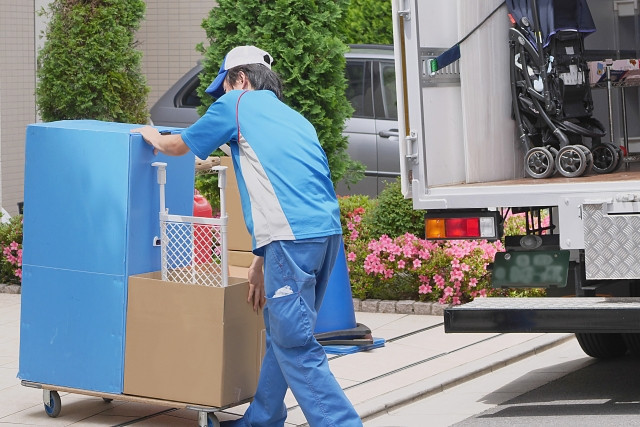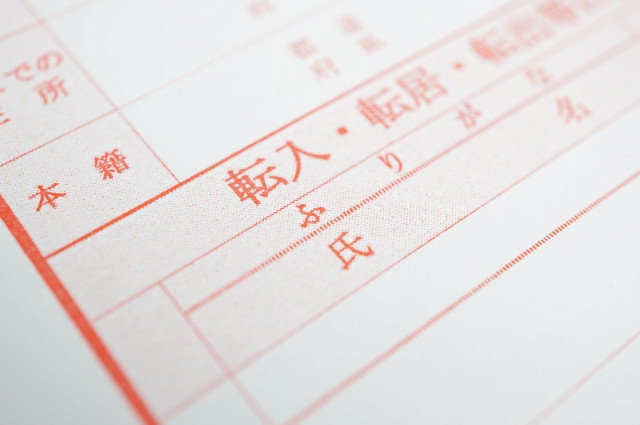Hikkoshi (引っ越し) is the Japanese word for moving house or changing residence. In this article, we introduce all you need to know about the moving process in Japan. There are many things to do such as updating your address record, finding a moving company, packing and disposing of unwanted items, cancelling and contracting utilities, and finally the big move-in day.
Table of Contents
- Moving in Japan Checklist
- Matters that Require Change of Address Following a Move
- Preparing to Move in Japan
- What to do on the Moving Day
- What to do After Moving
- Recommended Moving Companies in Japan (with English support)
- To Close
Moving in Japan Checklist

There are many important procedures to complete when moving in Japan, for example cancelling your current rental contract, dealing with public utilities, and notification of address changes to local municipality offices. Below, we provide a checklist of the most important things you need to handle before going into a little more detail into each.
-
Finalise new residence contract.
-
Cancel old residence contract.
-
Cancel utilities (water, electricity, gas) in the old residence.
-
Contract utilities (water, electricity, gas) for the new residence.
-
Contact internet, television, telephone landline company to update address.
-
Submit moving-out notification to old residence local municipality office.
-
Submit moving-in notification to new residence local municipality office.
-
Submit mail forwarding notice to the post office.
-
Procedures for children like transferring schools etc..
Rental Contract Procedures
Residents of rental accommodations need to complete the rental agreement termination procedure when they move out. A request of cancellation needs to be submitted to the management company or landlord generally within 1 to 2 months before the moving date.
If the termination procedure is not completed in time to meet the deadline set by the management company or landlord, you may have to pay for the next month’s rent as well. Once you have decided to move out, check the terms and conditions of your tenancy agreement carefully and make contact as soon as possible.
Utilities (Water, Electricity, Gas) Procedures
In Japan, utilities are the tenant’s responsibility, which means you are responsible for cancelling and contracting utilities at your old place and new place. Once your moving-out date has been decided, then make arrangements for utilities to be cancelled on that date. At the same time, also make arrangements for utilities to begin at your new place on the moving-in date.
For clearer instructions on cancelling and setting up utilities in Japan, read Utilities in Japan: How to Set-Up When First Moving In.
Internet, Landline and TV Network Procedures
If you wish to continue using these services at the new residence, then contact the service provider. In some cases, you may not be able to continue using the service, for example if your new residence is outside coverage, or in the case of cable internet, the new place does not have internet lines installed. If installation of internet lines or phone lines are necessary at your new residence, then contact the line installation contractors to arrange the time and date for installation works as soon as you can. Not only do you need to be present during the installation, it may also take up to 1 month from application to installation.
In the case of TV, such as NHK and satellite broadcasts, simply update your address online. Remember to bring the satellite dish (if you have) with you to your new location.
For more information about how home internet in Japan works, read How Does Home Internet in Japan Work
Moving-In & Moving-Out Notification Procedures
Note that the procedures and required submissions are different depending on where you are moving to.
How to Change Address When Moving to a Different Municipality
If you are moving to a different municipality, you will need to submit a “moving-out notification (転出届)” to the municipality office of the municipality you are moving out of, and a “moving-in notification (転入届)” to the municipality office of the municipality you are moving into. The former needs to be done within 14 days of you moving out, and the latter within 14 days of you moving in.
If you have a registered seal (印鑑登録) with the municipality office, then you need to submit a notice to cancel it. And if you want to, register it with the new municipality office.
Additionally, if you are registered with the National Health Insurance system, then you will also need to complete the disqualification procedure. And then, register with the municipality office.
How to Change Address When Moving Within the Same Municipality
If you are moving within the same municipality, then you only need to submit a “change of address notification (転居届)” within 14 days of moving. The address for your registered seal will automatically be updated, so you do not need to carry out a separate procedure.
However, you will need to re-register for National Health Insurance (if you use it) as the address will not update automatically.
Mail Forwarding Notification Procedure
The “mail forwarding notification (郵便物の転送届)” is a system that let's mail addressed to your old address be forwarded for delivery to your new address instead. The notification can be submitted at the post office, by post, or online.Mail forwarding can be set-up for up to 1 year, so within that year have your address on all platforms updated.
Setting-up mail forwarding before you move is highly recommended to avoid problems with your mail getting delivered to your old address.
Procedures for Children’s School Transfer or Admission to New School
School transfer procedures are something you need to settle if you have children attending preschool or school. Once you have decided on the moving date, inform the educational institution that your child is attending. Submit the necessary paperwork for transfer, and complete the enrolment procedures at the new kindergarten or school.
The documents required may differ from school to school. Check in advance and prepare accordingly.
Writer's Pick
Matters that Require Change of Address Following a Move

Once you have decided to move, you will need to report your planned moving date, new address, and new commuting mode and route to the company you work for. The change of address, which may affect your commuting mode and route, may result in a change of your commuting allowance and taxation. Other services that require you to update your address following a move include:
- Credit Card
- Bank
- SIM Card
- Mobile Wi-Fi
- Insurance
- Newspaper Subscription
- Driver’s Licence
- Parking Space
- Automobile Inspection Certificate
- Bike Registry
- Mail Order / E-commerce
- Resident Card
- My Number Card
- Passport (if changing registered domicile address)
Foreign national residents need to change the address on their resident card. This can be done at the municipality office with jurisdiction over the new address at the same time when submitting the moving-in notification or change of address notification.
Preparing to Move

There are many tasks to complete before the moving day. Below is a summary of what you need to do. Have a look so you don’t miss anything out.
Finding a Moving Company
There are many moving companies in Japan with different rates, moving packages, and special benefits. There are also some that offer services in English if you are not confident with your Japanese. Once you have decided to move, look up moving companies to see which ones offer the best rates and what services they offer.
If you have spare time to pack, you can choose a basic moving package that helps with packing up large furniture only. In this case, you will need to pack items into boxes yourself, and the movers will help with loading and unloading those boxes. If you are a busy person, then you can choose the no-hassle premium package where the movers will pack up all your belongings for you, bring it to your new place, and even unpack it for you.
Once you have decided on a moving company, make an appointment for them to visit your home where they will evaluate the size and number of items and give you a quotation. Whilst haggling is not customary in Japan, it is quite normal and acceptable for moving companies, so if you find the price too high, do try to have them lower the price. They may also offer suggestions to help you bring down the price, like moving on weekdays or using used boxes instead of new ones.
For moving company recommendations, go further down.
Packing Up All Your Stuff
You can get cardboard boxes and packing tape from the moving company, buy them yourselves at hardware stores, or ask for unwanted cardboard boxes from shop assistants at the supermarket. In the case of moving companies, depending on the moving company and the package you choose, they may supply them for free. If you are not picky about using new cardboard boxes, moving companies may offer used ones for free or heavily discounted prices.
When packing, start with items that are not used everyday. Off-season clothing, dishes, and books that are not used very often should be packed first. Kitchen utensils, toiletries, and other items you need to use till the last minute should be left to pack the day before or on the moving date.
Pack items into boxes according to which room they are to be unpacked in the new place. On the box, write down what items are inside and what room it is assigned to. This way, it will make things easier on the moving day. The moving company will also help put the boxes into those rooms.
Clean Up Old House and Organise Appliances
The day before you move out, clean up any areas of the soon-to-be old place that are badly dirty. Cleaning up little by little will reduce the amount of work you have to do on moving day.
-
Organise wiring for TV, computers, etc.
-
Clear out food and clean the fridge
-
Drain water from washing machine, especially pipes
-
Wipe down water, walls, and windows
If you are renting a property, the amount of refundable deposit may be reduced if the property is in poor condition when you move out. Therefore, it is best to prepare the property to be handed back in clean condition.
Dispose of Unwanted Items and Oversize Garbage
Unwanted furniture and appliances should be disposed of properly by waste collection or oversized garbage collection. How to dispose depends on the garbage contractor and local authorities, so research in advance and make the necessary appointment booking to have them come and collect, or bring the garbage to a designated collection point.
Furniture and appliances that are still usable can be sold on online used items marketplaces, internet auctions or recycle shops. As it may take some time to tell, it is recommended to have them put up on sale as soon as possible after you’ve decided to move.
Check the Condition of New Home and Furniture Arrangement
Once you have decided on your new place, pay a visit to check for any damages. Any existing defects before moving in should be reported to the management company or landlord, so that you will not be charged for cleaning or repairs later. Once you have checked the condition of the room, take dimension measurements of the route from the entrance to the rooms - genkan (front entrance), doorways, elevator. Just to confirm that your stuff can pass through without issue.
You should also take the dimension measurements of each room. Particularly, the washing machine’s drainage, television cable terminals area, and bedroom, so you can confirm that your existing furniture fits. Knowing the dimensions is also helpful when buying any new furniture or appliances.
What to Do on Moving Day

If you have followed the steps accordingly thus far, then things should proceed smoothly on the moving day. On that day, things to do include:
- Final packing and moving of belongings
- Final cleanup and handing back the old place to the management company or landlord
- Receiving belongings at the new place
- Paying the moving company
- Opening of gas tap at the new place
For water and electricity, there is nothing you need to do on the moving day as long as you have completed the procedures for cancellation at the old place and contracting at the new place beforehand. For gas, do not forget to be present at the old place when someone comes to turn off the gas. In certain cases, the closing of gas can be done without you being present, so check beforehand.
What to Do After Moving

After you have moved to your new place, bring the “moving-out certificate (転出証明書)” that you received when submitting your “moving out notification” and your personal identification documents to the municipality office with jurisdiction over the new address to submit a “moving-in notification (転入届)”. At the same time, complete other procedures such as registering for National Health insurance, updating address on resident card, updating address on My Number Card, and registering personal seal.
Another important thing to remember is the refundable deposit of the old place. If the refund is done by bank transfer, then check your bank account transactions. If it is by cash, then remember to go collect it.
Recommended Moving Companies in Japan

Among the many moving companies in Japan, there are some with multilingual support or have websites in English. Some well-known Japanese moving companies with foreign language support include:
- Sakai Moving Service : Highly recognisable panda logo. More than 200 branches nationwide. English-language support is available.
- Nippon Express : Supports 14 languages, including English, Chinese and Arabic.
- Yamato Home Convenience : Famous black cat carrying kitten logo. Website with detailed moving process in English.
- Tokyo Move : English only service centred in and around Tokyo, services not available nationwide.
- Best Moving Service : English support available, and in certain areas, English-speaking movers. Many complimentary benefits available.
A popular moving company in Japan is Art Corporation. You may have seen their moving vans around town with the numbers “0123” in white. Their services are only in Japanese.
To Close

When moving in Japan, there are many things that need to be done. Follow the steps in this article and you should have no problem. Note that if you miss a step or forget to complete a procedure, it may result in incurring more fees. When moving in Japan, make a proper checklist and schedule of what needs to be done and when to get things done in an orderly manner and to make the moving process a smooth one.


































